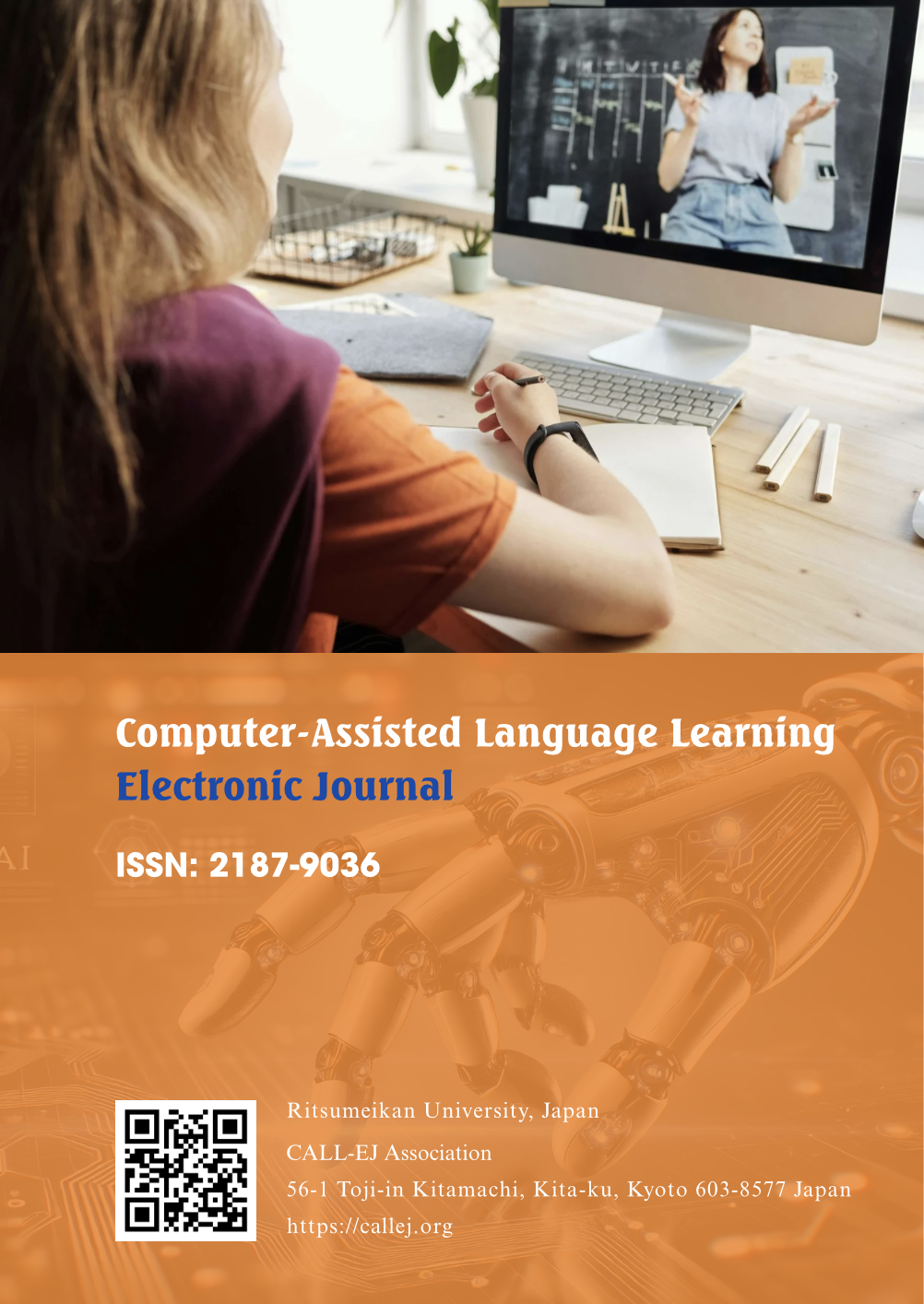Abstract
Despite numerous entrepreneurial products and services capitalizing on the opportunities afforded by CALL, there is a noticeable lack of entrepreneurial perspectives and analyses in CALL-related literature. This study explores four CALL academic entrepreneurs and the CALL products they developed. It aims to identify the distinctive products generated, the target customer base, and the entrepreneurial goals of the academic entrepreneurs. The study highlights that CALL products are highly contextual and are influenced by personal experiences, interests, and professional expertise. The study's findings were utilized to create a CALL entrepreneurial products model. These findings have the potential to inform future research in this area and offer valuable guidance to policymakers and stakeholders seeking to support and foster the development of CALL academic entrepreneurship in diverse settings.
References
Ardichvili, A., Cardozo, R., & Ray, S. (2003). A theory of entrepreneurial opportunity identification and development. Journal of Business Venturing, 18(1), 105-123.
Baron, R. A. (2006). Opportunity recognition as pattern recognition: How entrepreneurs ‘connect the dots’ to identify new business opportunities. Academy of management perspectives, 20(1), 104-119.
Beatty, K. (2013). Teaching & esearching: Computer-assisted language learning. New York, NY: Routledge.
Davies, G., Otto, S. E., & Rüschoff, B. (2013). Historical perspectives on CALL. In M. Thomas, H. Reinders, & M. Warschauer (Eds.), Contemporary computer-assisted language learning (pp. 19-38).
De Silva, L.R. (2012). Academic entrepreneurship in a resource-constrained environment. [Unpublished doctoral dissertation]. The University of Manchester.
Garrett, N. (2009). Computer‐assisted language learning trends and issues revisited: Integrating innovation. The Modern Language Journal, 93(s1), 719-740.
Hubbard, P. (2019). Five keys from the past to the future of CALL. IJCALLT, 9(3), 1-13. https://doi.org/10.4018/IJCALLT.2019070101.
Hubbard, P., & Levy, M. (2006). The scope of CALL education. In Hubbard, P., & Levy, M. (Eds.), Teacher education in CALL (pp. 3-20). John Benjamins.
Kang, E., & Uhlenbruck, K. (2006). A process framework for entrepreneurship: From exploration, to exploitation, to exit. Academy of Entrepreneurship Journal, 12(1), 47-72.
Karatay, Y., & Hegelheimer, V. (2021). CALL teacher training--considerations for low-resource environments: Overview of CALL teacher training. CALICO Journal, 38(3), 271-295.
Kessler, G. (2007). Formal and informal CALL preparation and teacher attitude toward technology. Computer Assisted Language Learning, 20(2), 173-188. https://doi.org/10.1080/09588220701331394.
Kessler, G. (2017). Preparing CALL professionals: A survey course in a CALL degree programme. In J.B. Son, & S. Windeatt (Eds.), Language teacher education and technology: Approaches and practices (pp. 111-128). London: Bloomsbury.
Kessler, G., & Hubbard, P. (2017). Language teacher education and technology. In C.A. Chapelle & S. Sauro (Eds.), The handbook of technology and second language teaching and learning (pp. 278-292). John Wiley & Sons.
Lai, C., Ni, R., & Zhao, Y. (2013). Digital games and language learning. In M. Thomas, H. Reinders, & M. Warschauer (Eds.), Contemporary computer-assisted language learning (pp. 183-200). London: Bloomsbury.
Levy, M. (1997). Computer-assisted language learning: Context and conceptualization. Oxford, UK: Clarendon Press.
Levy, M., & Stockwell, G. (2013). CALL dimensions: Options and issues in computer-assisted language learning. New York: Routledge.
Lindsey, L. (2009). Academic entrepreneurship in instructional technology. [Unpublished doctoral dissertation]. University of Virginia, Charlottesville, VA, USA.
Lubua, F. G., & Kessler, G. (2022). Academic entrepreneurship in CALL: A significant subject in the era of knowledge economy. IJCALLT, 12(1), 1-16.
Manion, M. (2002). Creative thinking or concept development? The process of recognizing successful opportunities for technologically complex new ventures. Academy of Entrepreneurship Journal, 8(2), 115-135.
Meticulous Research (2022, October 03). Online language learning market worth $31.81 billion by 2029. Meticulous Research. Retrieved 22 March 2023, from https://www.meticulousresearch.com/pressrelease/286/online-language-learning-market-2029.
McKenzie, B., Ugbah, S. D., & Smothers, N. (2007). ‘Who Is an Entrepreneur?’ Is It Still the Wrong Question?. Academy of Entrepreneurship Journal, 13(1), 23-43.
Mose, P., & Lubua, F. (2017). Rethinking African Languages Pedagogy in the Age of Technology. In D. Maganda (Ed.), The literature of language and the language of literature in Africa and the diaspora (pp. 173-188). Abuja, Nigeria: Adonis & Abey.
Robin, R. M. (2013). CALL and less-commonly taught languages. In M. Thomas, H. Reinders, & M. Warschauer (Eds.), Contemporary Computer-Assisted Language Learning (pp. 303-321). London: Bloomsburry.
Rose, D., & Patterson, C. (2016). Research to Revenue: A Practical Guide to University Start-ups. Chapel Hill, NC: UNC Press.
Sebastian, P. (2020). Language centers in the age of ubiquitous technology and eclectic methodology. IJCALLT, 10(3), 67-78. https://doi.org/10.4018/IJCALLT.2020070105.
Shane, S. (2004). Academic entrepreneurship: University spin-offs and wealth creation. Northampton, MA: Edward Elgar.
Siegel, D. S., & Wright, M. (2015). Academic entrepreneurship: Time for a rethink?. British Journal of Management, 26, 582-595. https://doi.org/10.1111/1467-8551.12116.
Sykes, J. M. (2018). Digital games and language teaching and learning. Foreign Language Annals, 51, 219-224. https://doi.org/10.1111/flan.12325.
Venkataraman, S. (1997). The distinctive domain of entrepreneurship research. Advances in Entrepreneurship, Firm Emergence, and Growth, 3(1), 119-138.
Vorobel, O., & Smith, B. (2020). Publishing on CALL products: Guidelines for authors and developers. CALICO Journal, 37(3), i-x.
Yin, R. K. (2014). Case study research: Design and methods, (5th ed.). Thousand Oaks, CA: Sage.

This work is licensed under a Creative Commons Attribution 4.0 International License.
Copyright (c) 2025 Author and CALL-EJ

